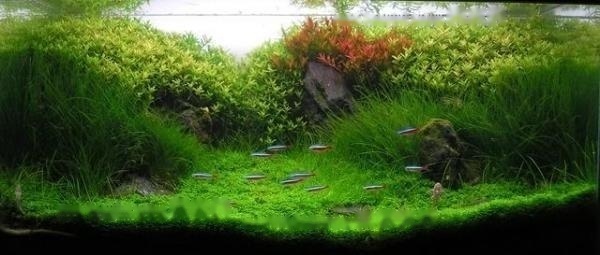
Cultivating aquatic plants in an aquarium not only enhances the value of the aquarium landscape, but also helps the ecological environment. Whether in terms of design or breeding, aquatic plants play a major role. Let's follow the editor to understand the cultivation of aquatic plants.
1. The benefits of raising aquatic plants in aquariums
1. Aquatic plants release oxygen
It is well known that aquatic plants can perform photosynthesis and release oxygen into water for supply under the condition of light. Fish and nitrifying bacteria are used to make the aquarium less prone to hypoxia.
2. Sufficient oxygen use
If there are only a few fish in the aquarium, the oxygen released by the water plants through photosynthesis is enough for the fish to use, and there is no need to pump oxygen into the water. .
3. Absorb waste toxins
In fact, aquatic plants also absorb waste and toxins during the growth process. This is very helpful to maintain a balance and stabilize the water quality environment.
4. Bacterial decomposition and absorption
Aquatic plants can absorb the food decomposed by bacteria and the excrement of fish, make the water clear and clean, and purify the water environment. Children can grow up healthily and steadily.
5. Prevent the growth of algae
There is another function: to prevent the growth of algae, it provides an important survival interface for nitrifying bacteria. Healthy aquatic plants have obvious advantages in competing with algae for nutrients, and aquatic plants also provide fish with the best place for refuge and reproduction.
2. Aquatic grass trimming and maintenance skills
6. Improve the appreciation value
Plant some aquatic plants in the aquarium and use some artificial stones and rockeries to make landscaping, so that It can improve the appreciation value of the entire aquarium. However, after planting aquatic plants, it is also necessary to maintain and trim aquatic plants in time.
7. Pay attention to pruning aquatic plants
There are many kinds of aquatic plants, and different aquatic plants have different shapes and sizes. Some aquatic plants have stems, some are clumps, some are bulbous plants, etc. When pruning different species aquatic plants, the aspects to be paid attention to are also different.
8. Prepare to use tools
Before maintenance and pruning, prepare tools for use, such as sharp weed shears, which can be bought in aquariums or flower and bird markets tool.
9. Cut off the rotten leaves
If you want to prune stemmed aquatic plants, you should prune about 5 cm above the bottom bed in the first pruning, and the second time you need to prune them. Prune at 8-10 cm, and trim off old, rotten leaves. If pruning bulbs, trim off the newly grown floating leaves near the roots.
10. The incision is neat and complete
Be sure to cut the incision of the page neatly when trimming, so you cannot use blunt scissors, because if the incision on the leaf surface of the aquatic plants is not complete, it will be damaged. It leads to necrosis and decay of incision cells after planting, thus affecting the growth of aquatic plants.
3. Precautions for aquaculture liquid fertilizers
11. Liquid fertilizers for success or failure of aquaculture
Liquid fertilizers are the most commonly used nutrients for aquaculture. Experienced aquarists summarize: The cultivation of aquatic plants is also liquid fertilizer and liquid fertilizer. Therefore, the use of liquid fertilizer cannot be casual, and the amount of liquid fertilizer or the variety of liquid fertilizer will directly affect the normal growth of aquatic plants.
12. Pay attention to aquatic plants liquid fertilizer
When adding liquid fertilizer, do not add liquid fertilizer directly to the very sensitive aquatic plant shoots, especially in the grass tank with slow water flow. This is because it is easy to cause a high concentration of salt environment in the local area and cause damage to aquatic plants.
13. The problem of adding dosage
Pay attention to the dosage of liquid fertilizer. The purpose of adding liquid fertilizer is to make the nutrients in the limited water body of the grass tank sufficient and balanced, but this adequacy and balance are not Just by adding.
14. Bacterial absorption and consumption
The amount of liquid fertilizer is determined according to the absorption of aquatic plants and nitrifying bacteria and the natural consumption of elements. If the water plants are dense, high light and high carbon, there are many positive grasses, frequent water changes, and the water plants are in a vigorous growth period, the fertilizer consumption is large and the natural loss is high, so more liquid fertilizer can be added appropriately.
![[Dog Training 5] The training method of pet dog dining etiquette](/static/img/12192/12192_1.jpg)




